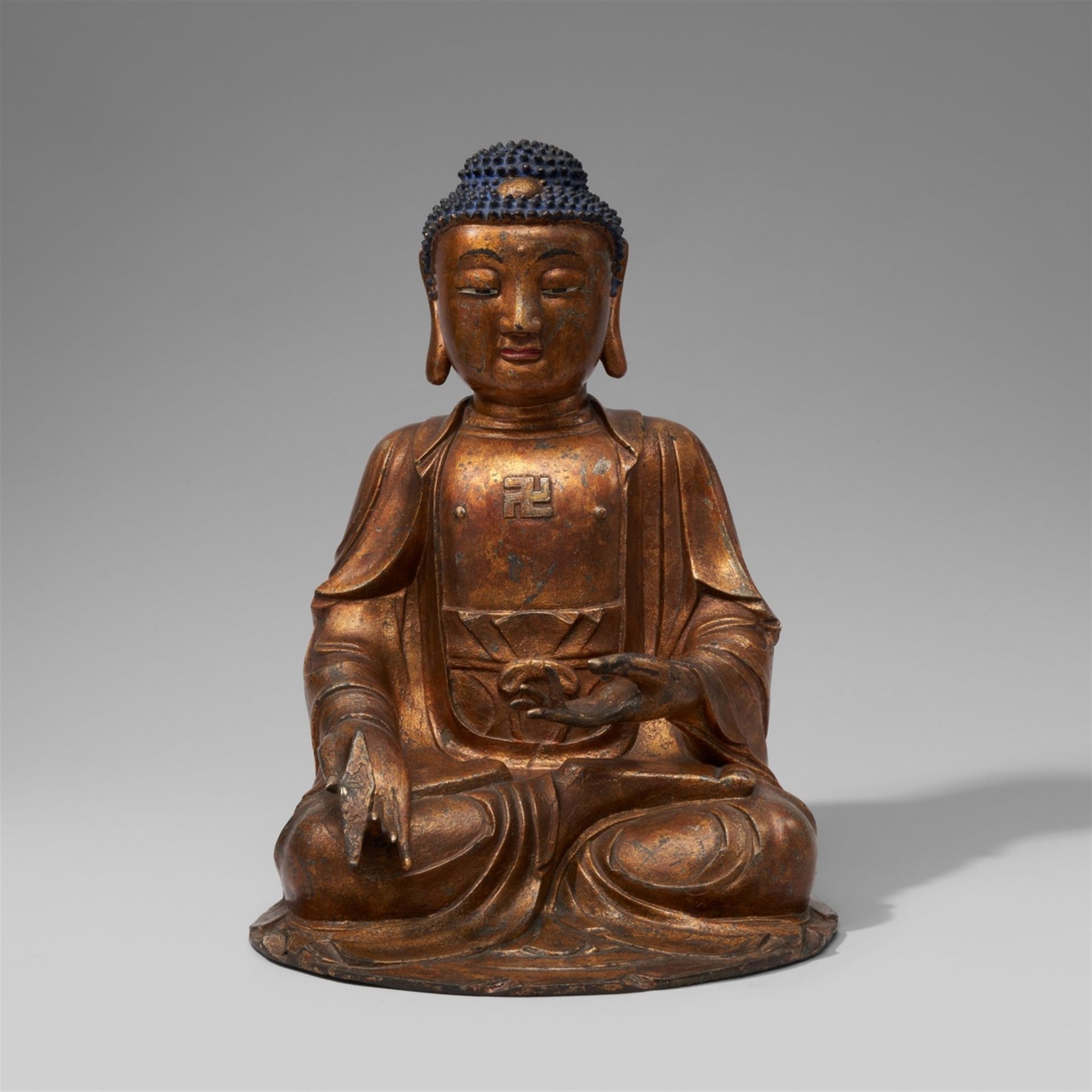Description
A lacquered bronze figure of Bhaishajyaguru, the Medicine Buddha. 17th/18th century Seated in meditation (padmasana), the right hand with a myrobalan fruit placed on the knee, the left hand held forward. The robes open to reveal the chest with a swastika in relief and tiny nipples, the antaravasaka (chin. neiyi) is held together at the waist with a belt tied into a bow, while the uttarasanga (chin. shangzhuoyi) and kasaya cover the rest of the body, only the hem of the undergarment is engraved with blossoms and scrolls. The robe flares out fan-like in front, forming a flat base for the seated figure.The full face is accentuated by painted brows, eyes and red lips, a large urna is reserved from the hair curls painted blue and covering the ushnisha. On the basis of the myrobalan fruit, the simple garment covering both shoulders and the complete lack of jewellery, this figure can be identified as the Buddha of Medicine, chin. Yaoshi fo. He is also called the Healing Buddha, and is said to dispense spiritual medicine when properly worshipped. It is even believed tat an efficacious cure may be accomplished by merely touching the image. The figure is represented in the pure Han-Chinese style, without any iconographic or stylistic influence of the Tantric or Tibetan Buddhism prevalent at the imperial court. Such sculptures were generally donated to a Buddhist temple by private persons. They were placed on the large wooden altar, which displayed the main figures of worship, usually a triad of Buddhas or Bodhisattvas. To the sides and in front of them smaller Buddhist figures were randomly arranged. As objects of worship they were sometimes donned with a cloth placed around their shoulders. Height 50.2 cm Provenance Private property, since the 1950s, Frankfurt Literature Compare a similar figure sold in these rooms 15./16.12.2020, lot 109
57 .a
A lacquered bronze figure of Bhaishajyaguru, the Medicine Buddha. 17th/18th century Seated in meditation (padmasana), the right hand with a myrobalan fruit placed on the knee, the left hand held forward. The robes open to reveal the chest with a swastika in relief and tiny nipples, the antaravasaka (chin. neiyi) is held together at the waist with a belt tied into a bow, while the uttarasanga (chin. shangzhuoyi) and kasaya cover the rest of the body, only the hem of the undergarment is engraved with blossoms and scrolls. The robe flares out fan-like in front, forming a flat base for the seated figure.The full face is accentuated by painted brows, eyes and red lips, a large urna is reserved from the hair curls painted blue and covering the ushnisha. On the basis of the myrobalan fruit, the simple garment covering both shoulders and the complete lack of jewellery, this figure can be identified as the Buddha of Medicine, chin. Yaoshi fo. He is also called the Healing Buddha, and is said to dispense spiritual medicine when properly worshipped. It is even believed tat an efficacious cure may be accomplished by merely touching the image. The figure is represented in the pure Han-Chinese style, without any iconographic or stylistic influence of the Tantric or Tibetan Buddhism prevalent at the imperial court. Such sculptures were generally donated to a Buddhist temple by private persons. They were placed on the large wooden altar, which displayed the main figures of worship, usually a triad of Buddhas or Bodhisattvas. To the sides and in front of them smaller Buddhist figures were randomly arranged. As objects of worship they were sometimes donned with a cloth placed around their shoulders. Height 50.2 cm Provenance Private property, since the 1950s, Frankfurt Literature Compare a similar figure sold in these rooms 15./16.12.2020, lot 109
